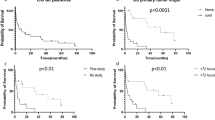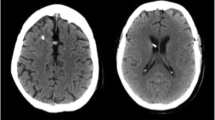Abstract
Ventricular access devices (VAD) offer several advantages compared to intralumbar injections for the administration of intra-CSF agents in the treatment of leptomeningeal metastases (LM). However, there are few prospective studies reporting on complications with the use of VADs. All complications were prospectively collected that pertained to the implantation and use of a VAD in consecutive patients with solid tumor-related LM from June 2006 to December 2013. Clinical follow-up was every 2 weeks during the initial 2 months of treatment and then once monthly. Complete neuraxis MRI was performed at baseline and then every 2–3 months. A total of 112 patients (88 women) with a mean age of 51.1 years (range 26–73) were included. Primary cancers included breast (79 patients), lung (12) and melanoma (6). All patients were treated with intra-CSF liposomal cytarabine. 72 % of the patients received concomitant systemic and intra-CSF chemotherapy. The placement of the VAD was performed under local anesthesia in all cases. The mean operative time was 15 min and no perioperative complications were reported. The mean number of intraventricular injections per patient was 9.34 (range 1–47). A total of 11 complications in 11 patients were seen including 7 infections, 1 intracranial hemorrhage, 2 instances of symptomatic leukoencephalopathy and 1 catheter malpositioning. 8 complications required an operation and 1 complication was fatal. The use of a VAD is safe and may improve patients’ comfort and compliance with LM-directed therapy.

Similar content being viewed by others
References
Yap HY, Yap BS, Tashima CK, DiStefano A, Blumenschein GR (1978) Meningeal carcinomatosis in breast cancer. Cancer 42:283–286
Amer MH, Al-Sarraf M, Baker LH, Vaitkevicius VK (1978) Malignant melanoma and central nervous system metastases: incidence, diagnosis, treatment and survival. Cancer 42:660–668
Grossman SA, Krabak MJ (1999) Leptomeningeal carcinomatosis. Cancer Treat Rev 25:103–119
Le Rhun E, Taillibert S, Chamberlain MC (2013) Carcinomatous meningitis: leptomeningeal metastases in solid tumors. Surg Neurol Int 4:S265–S288
Chamberlain MC (2005) Neoplastic meningitis. J Clin Oncol 23:3605–3613
DeAngelis LM (1998) Current diagnosis and treatment of leptomeningeal metastasis. J Neurooncol 38:245–252
Blaney SM, Poplack DG (2000) Neoplastic meningitis: diagnosis and treatment considerations. Med Oncol 17:151–162
Pace P, Fabi A (2006) Chemotherapy in neoplastic meningitis. Crit Rev Oncol Hematol 60:528–534
Brem SS, Bierman PJ, Black P, Blumenthal DT, Brem H, Chamberlain MC et al (2008) Central nervous system cancers: clinical practice guidelines in oncology. J Natl Compr Cancer Netw 6:456–504
Bokstein F, Lossos A, Siegal T (1998) Leptomeningeal metastases from solid tumors: a comparison of two prospective series treated with and without intra-cerebrospinal fluid chemotherapy. Cancer 82:1756–1763
Chamberlain MC (2009) Leptomeningeal metastasis. Curr Opin Neurol 22:665–674
Glantz MJ, Van Horn A, Fisher R, Chamberlain MC (2010) Route of intracerebrospinal fluid chemotherapy administration and efficacy of therapy in neoplastic meningitis. Cancer 116:1947–1952
Shapiro WR, Young DF, Mehta BM (1975) Methotrexate: distribution in cerebrospinal fluid after intravenous, ventricular and lumbar injections. N Engl J Med 293:161–166
Ratcheson RA, Ommaya AK (1968) Experience with the subcutaneous cerebrospinal-fluid reservoir. Preliminary report of 60 cases. N Engl J Med 279:1025–1031
Obbens EA, Leavens ME, Bed JW, Lee YY (1985) Ommaya reservoirs in 387 cancer patients. A 15-year experience. Neurology 35:1274
Sandberg DI, Bilsky MH, Souweidane MM, Bzdil J, Gutin PH (2000) Ommaya reservoirs for the treatment of leptomeningeal metastases. Neurosurgery 47:49–55
Ommaya AK (1963) Subcutaneous reservoir and pump for sterile access to ventricular cerebrospinal fluid. Lancet 282:983–984
Lishner M, Perrin RG, Feld R, Messner HA, Tuffnell PG, Elhakim T, Matlow A, Curtis JE (1990) Complications associated with Ommaya reservoirs in patients with cancer: the Princess Margaret Hospital experience and review of the literature. Arch Intern Med 150:173
Bleyer WA, Pizzo PA, Spence AM, Platt WD, Benjamin DR, Kolins CJ, Poplack DG (1978) The Ommaya reservoir. Newly recognized complications and recommendations for insertion and use. Cancer 41:2431–2437
Zairi F, Le Rhun E, Tetard MC, Kotecki N, Assaker R (2011) Complications related to the placement of an intraventricular chemotherapy device. J Neurooncol 104:247–252
Balm M, Hammack J (1996) Leptomeningeal carcinomatosis: presenting features and prognostic factors. Arch Neurol 53:626–632
Glantz MJ, Cole BF, Glantz LK, Cobb J, Mills P, Lekos A, Walters BC, Recht LD (1998) Cerebrospinal fluid cytology in patients with cancer: minimizing false-negative results. Cancer 82:733–739
Brem SS, Bierman PJ, Brem H, Butowski N, Chamberlain MC, Chiocca EA et al (2011) National comprehensive cancer network, central nervous system. J Natl Compr Canc Netw 9:352–400
Jaeckle KA (2006) Neoplastic meningitis from systemic malignancies: diagnosis, prognosis, and treatment. Semin Oncol 33:312–323
Clarke JL, Perez HR, Jacks LM, Panageas KS, Deangelis LM (2010) Leptomeningeal metastases in the MRI era. Neurology 74:1449–1454
Chamberlain MC, Kormanik PA, Barba D (1997) Complications associated with intraventricular chemotherapy in patients with leptomeningeal metastases. J Neurosurg 87:694–699
Pirotte BJ, Lubansu A, Bruneau M, Loqa C, Van Cutsem N, Brotchi J (2007) Sterile surgical technique for shunt placement reduces the shunt infection rate in children: preliminary analysis of a prospective protocol in 115 consecutive procedures. Childs Nerv Syst 23:1251–1261
Mead PA, Safdieh JE, Nizza P, Tuma S, Sepkowitz KA (2014) Ommaya reservoir infections: a 16-year retrospective analysis. J Infect 68:225–230
Szvalb AD, Raad II, Weinberg JS, Suki D, Mayer R, Viola GM (2014) Ommaya reservoir-related infections: clinical manifestations and treatment outcomes. J Infect 68:216–224
Kosier MB, Minkler P (1999) Nursing management of patients with an implanted Ommaya reservoir. Clin J Oncol Nurs 3:63–67
Lishner M, Scheinbaum R, Messner HA (1991) Intrathecal vancomycin in the treatment of Ommaya reservoir infection by Staphylococcus epidermidis. Scand J Infect Dis 23:101–104
Siegal T, Pfeffer MR, Steiner I (1988) Antibiotic therapy for infected Ommaya reservoir systems. Neurosurgery 22:97–100
Bleyer WA, Pizzo PA, Spence AM, Platt WD, Benjamin DR, Kolins CJ, Poplack DG (1978) The Ommaya reservoir. newly recognized complications and recommendations for insertion and use. Cancer 41:2431–2437
Stone JA, Castillo M, Mukherji SK (1999) Leukoencephalopathy complicating an Ommaya reservoir and chemotherapy. Neuroradiology 41:134–136
Chowdhary SA, Chamberlain MC (2006) An unusual complication of Ommaya reservoirs and intraventricular chemotherapy. Neurology 67(2):319–320
Chamberlain MC (2012) Neurotoxicity of intra-CSF liposomal cytarabine (DepoCyt) administered for the treatment of leptomeningeal metastases: a retrospective case series. J Neurooncol 109:143–148
Conflict of interest
None.
Author information
Authors and Affiliations
Corresponding author
Rights and permissions
About this article
Cite this article
Zairi, F., Le Rhun, E., Bertrand, N. et al. Complications related to the use of an intraventricular access device for the treatment of leptomeningeal metastases from solid tumor: a single centre experience in 112 patients. J Neurooncol 124, 317–323 (2015). https://doi.org/10.1007/s11060-015-1842-x
Received:
Accepted:
Published:
Issue Date:
DOI: https://doi.org/10.1007/s11060-015-1842-x




